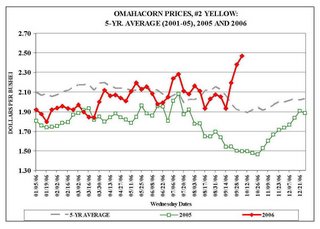Beef Market Advisor
Sunday, October 22, 2006
Fall 2006 Beef Outlook
by
Christ Hurt
Professor, Purdue University
Beef producers saw a dramatic outlook improvement on July 27th when the Japanese once again accepted imports of U.S. beef. While the news was not so dramatic, the price reaction to it was spectacular. Finished cattle prices rose from the high $70s in late July to near $90 by early September.
Beef supplies for the rest of 2006 and for 2007 are expected to be up about 2%. Beef cow numbers were up only .3% in July and milk cow numbers were up 1 %. The calf crop for 2006 is up only .3%. Thus, much of the 2% increase in beef supplies for 2007 will be from heavier weights.
Beef cow/calf operations are not indicating intentions to expand at this point since they have not increased the number of beef replacement heifers. Drought conditions from the Northern Plains to the Southern Plains also resulted in reduced herds from South Dakota to Texas this year. The dryness on the Plains provides an opportunity for the feed-rich Eastern Corn Belt producers to expand.
While exports have been opened to Japan, South Korea is still considering re-opening as of early September and total U.S. exports are expected to be slow to recover to their 2003 levels. Why? Japan, our largest beef buyer, largely replaced U.S. beef with other products including more beef from Australia and greater U.S. pork and broiler imports. Now, U.S. beef will have to "earn back" that business from other competitors.
This fall, finished steer prices are expected to be in the very high $80s to low $90s. A continuation of strong prices is expected in 2007 with first quarter prices averaging in the very low $90s and mid-to-higher $80 for the spring quarter.
Feeder cattle and calf prices should be near record highs this fall and winter. The record high quarterly price for 500 to 550 pound steer calves in Oklahoma City was $136 per hundredweight. Prices this fall are expected to be near those levels. Steer calves in Indiana and Kentucky are expected to be in the $120 to $130 range. Heifer calves may be $5 to $7 lower. These prices continue favorable profit levels for brood cow operations.
Prospects appear to be very good for cow/calf profitability again in 2007. Why? Exports should continue to build slowly; this year's small calf crop means modest increases in beef production next year; and if the Plains drought improves, more heifers will be retained for expansion.
In 2006, finished steer prices are expected to average about $86. For 2007 a new record high could be established, breaking the 2005 record of $87.18. However, rising corn prices may keep calf and feeder cattle from setting records also.
Indiana's major expansion of ethanol production will mean huge supplies of DDG's will become available in 2007. Production by late-2007 in the state will be about 1.7 million short tons. The abundance and low prices for this new feedstuff should stimulate interest in cattle feeding and dairy in the state.
posted by Dr. Harlan Hughes 2:26 PM [edit]

Corn Price Increasing
Corn prices this year have averaged above a year ago in response to a smaller corn crop and robust demand from the ethanol industry and rather strong exports. In late March, weekly corn prices for Omaha hit $2.00 per bushel and have generally continued on an upward price trend ever since. For the next few years, one of the biggest risks facing livestock producers will be feedstuff costs, especially corn.
Based on weekly data, for the first three quarters of this year Omaha corn prices averaged $2.04 per bushel compared to $1.81 last year, but about 3 percent below the 2000-2004 average. In mid-September corn prices weakened to $1 .94 per bushel and sparked some thoughts of relief in the cattle feeding and hog sectors for lower corn prices this fall. However, the following week, corn prices jumped to $2.20 per bushel, the largest week-to-week gain thus far this year and again to $2.38 per bushel by the end of the month. In early October, Omaha corn prices were over $2.40 per bushel. The last time, Omaha reported a higher weekly corn price was in mid-July of 2004.
Corn prices could moderate some this fall depending on the size of the 2006 corn crop. But, in the longer-term corn prices are expected to continue the upward trend mainly due to growing demand from the ethanol industry. Some industry forecasts call for cash corn prices to hit the $3.00 per bushel mark next year.
In recent weeks, feeder cattle and calf price declines have in large part been due to the upswing in corn prices. In LMIC calf and yearling price forecasts for 2007 and 2008, most of the forecasted declines in prices are a result of higher
corn prices. In fact, slaughter cattle prices will likely be rather flat compared to calf prices.
source: LMIC Denver,Co
posted by Dr. Harlan Hughes 5:55 AM [edit]

